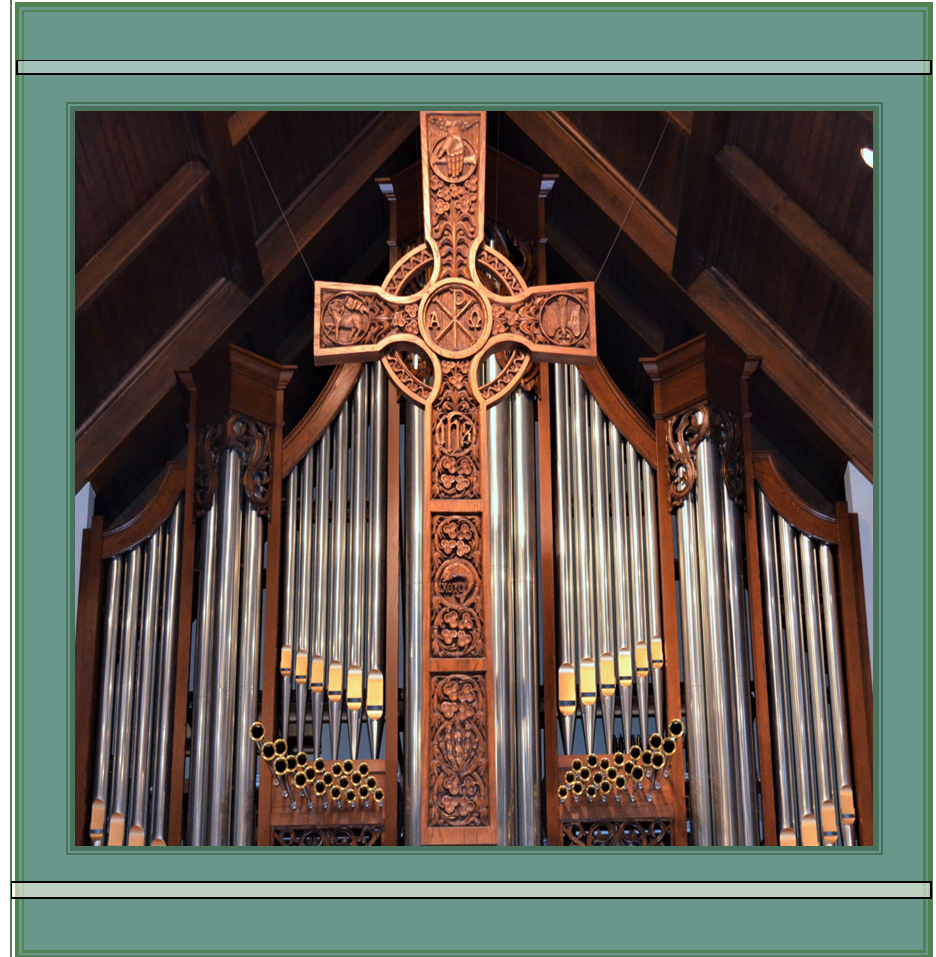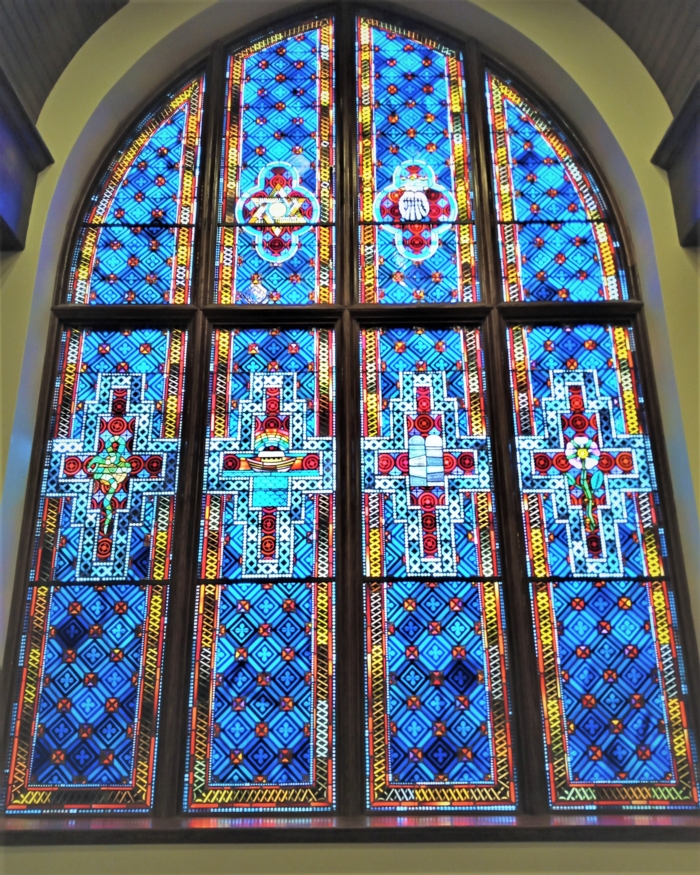The Old Testament
All information on First Presbyterian Church's beautiful stained glass windows has been copied from Kenneth C. Dobson's book that explains the history and presents information on various artifacts in the First Presbyterian Church of Alton.
|
|
|
There was not always a Gothic style stained glass window in the west transept. Indeed, this barrel-vaulted “alcove” was once the front of the sanctuary in the original Link design. There was an organ there, behind the chancel platform, with the pulpit strategically located at the acoustical center of the church. Aisles approached the chancel diagonally from the tower and the opposite corner at the back. But when the sanctuary was redesigned in 1963 and 1964, a window was installed there to match the window next to it. Both of those windows were then replaced with stained glass in colors appropriate to the new Gothic interior. The windows facing east included the Old Testament motif, and the west windows “the ones first see upon entering the church through the tower) included the New Testament symbols. In the 1991 reconstruction, the windows retained the same symbols but, the Old Testament windows were placed to the west, and the New Testament windows to the east – to receive the morning light as is traditional. People who have memorized the 1964 windows, when first seeing the new 1990 replacements, tend to think they are very different. As a matter of fact, only the symbols are the same, and even these are not identical. The 1991 windows had to be redrawn and remade following new patterns because a new firm was chosen for the project. The original firm proved to be uncooperative and unfriendly to the committee. The results, nevertheless, are striking, beautiful, and far exceeded every expectation in terms of technical and artistic effectiveness, brilliance of color, variety of color, and attention to detail. |
|
|
At the top of the Old Testament windows on the left, is a large six-pointed star that is composed, familiarly of two interlaced equilateral triangles, known as the Star of David. In the center of the star is a Hebrew word for the name of God. Throughout most of history, the Hebrew language was written with only consonants. The vowels which transformed the consonants into pronounceable syllables were known from memory, but were added in the middle ages to assist later readers who might be unfamiliar with the sound of spoken Hebrew. Rabbis simply went through scripture and added dots and dashes above and below the consonants to stand for vowels. However, there was one word that was written in the Bible which was never actually pronounced by the rabbis. In great fear of breaking the holy prohibition of the third commandment against taking the Lord’s name in vain, the rabbis avoided saying the word out loud which was printed in Exodus 3:14 in answer to Moses’s question about the name of God. God’s answer in English is “I AM.” Elsewhere the name is translated as God. The four Hebrew letters compare to English JHWH. We believe the missing vowels must have produced the work “JaHWeH”, meaning “I AM” or “I AM WHO I AM.” But the rabbis avoided saying that holy name. Instead, they articulated a euphemism for the name of God saying “AD-O-NAI’, which means “Lord.” Adonai is pronounced with the Hebrew vowel sounds a, o, a (ay). So when the rabbis were reading out loud, they said Adonai whether the word was written ADNY or JHWH. The results of adding the a-o-a vowels to the consonants JHWH is to produce the word JaHoWaH or Jehovah as the King James version has the sacred name of God in English. Recent translations try to propose that we go ahead and read the name of God as it was meant in the first place, using the a-e vowels to form the word JaHWeH. The artist in designing the windows in 1989, insisted on the old vowel markings even though he was asked to leave them off. The resulting word is a mixture of the consonants for the name of God – Yahweh – and the vowels for the name of God – Adonai. In any case, the meaning is that God is supreme over all. It is the Lord God who has sovereignty over all the events of history as represented in the four window below. |
|
The symbol on the right in the upper tier is the Hand of God extending from a bright cloud. Within the hand are five tiny figures representing the souls of the righteous. The idea is based upon Psalm 139, “Thy right hand shall hold me…” and from another passage, “…the souls of the righteous are in the hand of God.” (Wisdom of Solomon 3:1) The “righteous and the wise and their deeds are in the hand of God,” says the Preacher (Ecclesiastes 9:1). And from the Old Testament, the symbol was remembered by the early Christians who often referred to the Hand of God, especially the right hand, where Jesus is located. The picture of the Hand of God extending down toward Earth was often used in early Christian art to indicate the presence and providence of God. It is fair to say that the reign of God was progressively understood in Old Testament history. The earliest concept was that YHWH was a territorial God, who was sovereign in a particular area given to Abraham and his clan. In this concept, YHWH had to strive with other gods for dominance. “I am a jealous God” the prophets report. “Have no other gods before me.” But as the Hebrew people began to gain total control of their nation under King David and King Solomon, the thought caught hold that YHWH can protect the people and the nation from enemies because God is supreme over all other gods, no matter where they are. Within time, the prophets were proclaiming that only YHWH is real, that the others are idols of wood and stone without life or reality except in the imaginations of their deluded adherents. In fact, the prophets attributed the basic political weakness of Israel to the fact that the government (the kings) continued to tolerate the presence of other cults and places of worship within the country. Israel’s monotheism had become radical. Jesus’ contribution was to demonstrate how that radical monotheism must operate within the conscience as a matter of decision and will rather than public law and cultic practice, and to mobilize a group of people to become God’s expanding faith community – pushing beyond the borders of Palestine into “all the world, making disciples and baptizing…” Thus, the righteous in the Hand of God includes people of all nations, whoever confesses the sovereignty of YHWH God and is guided by principles of justice (righteousness) in relation to others. |
.png) |
|
|
The Bible insists that God created a good world, filled with life-giving fruit, in which all creatures live together peaceably and in which human beings even had intimate, direct companionship with God. It was paradise, picture as a garden of delight. The entrance of evil and perfidy into this picture is explained in several ways in scripture, but the central story of the fall from paradise is in the third chapter of Genesis. There, Adam and Eve (representing humankind – male and female) yielded to the beguiling temptation to try to expand the limits imposed on their humanity and indeed to strive to become “like God.” God perceived this to be rebellion which would undo the results of the ordering of creation, violating the distinctions and prerogatives set for each group of creatures. The snake was said to have suggested that the humans take the step of becoming like God. And it was in agreeing to this temptation that creation appeared to be on the way toward reverting to chaos, or at least toward being wrapped in the coils of rebellion (another word for sin) against God. Consequently, the picture which we inherit is less a vision of paradise that a portrait of the world encoiled in the serpent’s grip. Originally there was no identification of the serpent with Satan, but that suggestion was certainly popular by the New Testament era. In any case, the lock which sin and evil has on the world is temporary, as menacing and deadly as evil may be. In due time God will dispatch Satan and serpent and all else that disrupts the re-creation of paradise. |
|
As the Old Testament story continues, even with the disciplines imposed after expulsion from the Garden of Eden, humankind continued to degenerate from God’s model. As an example of God’s determination and compassion, Genesis tells the story of Noah, a righteous man who was head of a good family. The time came when they alone remained true. So God sent a flood to eradicate life from the face of the earth, but preserved Noah with pairs of all animals to repopulate the world when the flood receded. As a sign of God’s promise to preserve life against future devastation by such a flood, God consecrated the rainbow. The testament (or covenant) with Noah was the first of several which the Bible mentions in which God establishes himself as Lord over humankind and provides a symbol of his edict. God did judge and discipline his people several times but in a less general way, by forcing the restructure of Hebrew society through conquest by empires from outside for example. Still scripture predicts that a time will come when God’s patience will once again reach its limits and God will again remove his faithful people and will destroy the world God created. |
.png) |
|
|
|
|
|



.png)
.png)
.png)
.png)